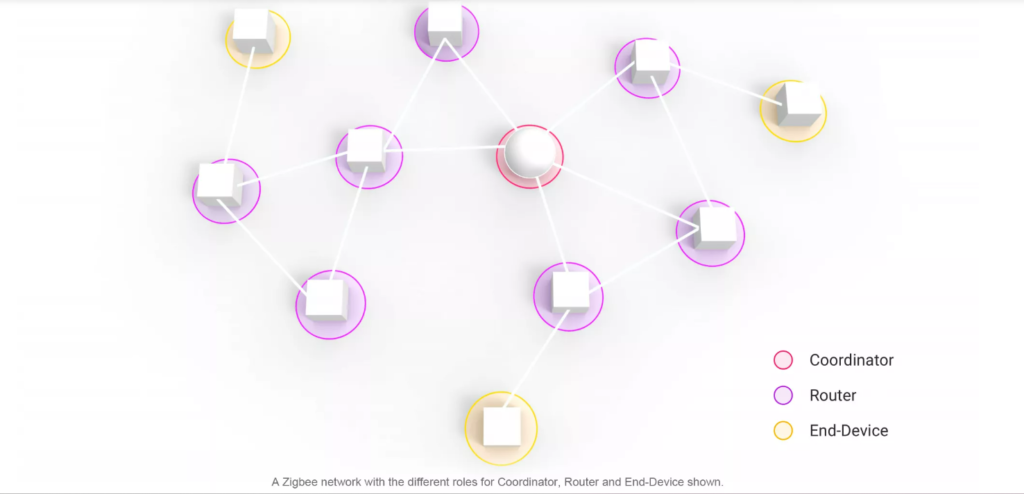
What is Zigbee?
Zigbee is a protocol used to link smart devices like lights, plugs, smart locks, and ventilation systems to a home network. You can use this home network as remote controls, like a Tradfri remote from IKEA. It won’t be very smart, but everything is connected and you’ll never have to get up to use a light switch. You can also link your Zigbee network to a hub. The hub serves as a “bridge” to the internet, offering cloud tools, apps, and (remote) control from your phone.
Zigbee is similar to, but different from, competing protocols like Z-Wave, Matter, Wi-Fi, and Bluetooth. They all create relatively secure networks, which you can (mostly) connect to a hub and control with your phone or a desktop app. The largest differences to a user are supported devices, with Zigbee offering more in terms of lights and smart plugs where other protocols support different smart devices.
Zigbee At a Glance:
- Wireless smart home technology
- Works on the 2.4GHz frequency
- Popular, relatively affordable alternative to Z-Wave, Matter, Wi-Fi and Bluetooth
- Standardized wireless protocol, so devices from different manufacturers can talk to each other
- Uses Mesh networking
- Cost-effective
- Secure 128-bit AES encryption
- Low-power usage / long battery life
- Range: 10-20 meters indoors, 75-300 outdoors
- IP connection for smartphone / tablet control when you connect a Zigbee hub

Why Use Zigbee?
Zigbee is not a perfect or “the absolute best” home automation technology, there are pros and cons. However, it does have a lot to offer consumers.
Better Remotes— If you have RF or Infrared devices at home, you’ll be pleased to know Zigbee is much better. If you do use a remote, you can point it anywhere to activate the connected device. Still, we’d recommend a smart hub, and that’s not just because we’re selling hubs. Smart hubs allow you to connect your Zigbee network to the web so you can use your phone as a remote, set up automation, and control your devices when you are not at home.
Connect to the Cloud – Zigbee links to the internet over the smart hub. A hub means you can control devices with apps on mobile, cloud, or desktop devices. It also means collecting usage data, setting up automation, and the option to invite multiple users who can control the same devices.
Secure – Zigbee uses 128-bit AES encryption keys, similarly to its primary competitor, Z-Wave. This plus short-range signals make Zigbee secure. Zigbee is secure by default. However, most home automation protocols have similar levels of security when you configure them properly. This isn’t so much a must-have point.
Stable Networks — Zigbee devices automatically reroute when one device in the network goes out. Your network won’t go down because you accidentally physically turned the hallway device off, unless that device is the single link between your network and the rest of the devices in the house.
Multi-Device — With support for many devices on a single network, you’ll never need more than one Zigbee hub. If you only want a few devices, you many need a Zigbee repeater or a different protocol if you’re spreading your smart devices over entire house.
Power-Efficient — Zigbee devices use very little energy when in standby, which greatly reduces electric usage and improves battery life where relevant.
Cost-Effective — Zigbee devices are notoriously affordable. Zigbee devices tend to be 20-50% cheaper than Z-Wave devices with the same functions, and also cheaper than devices on Thread or Matter. Since both the chips and the certification are easier and cheaper on Zigbee compared to Z-Wave, the difference will probably last.
At the same time, Zigbee definitely isn’t a one-size-fits-all solution.
You always need a hub to pair Zigbee to your mobile phone or a computer. Also, Zigbee is limited to one hub per system.
Zigbee networks have a limited range if you don’t add on more devices. Every Zigbee device must be within the limited range of at least one other Zigbee device at all times.
Not every smart device supports Zigbee. While Zigbee dominates the smart light market, you’re very likely to need another technology if you want sensors, switeches, Tvs, fans, or data streaming devices.
Finally, you are welcome to contact us for the best strategy to build up air quality controlling projects! Team Prodo Tech is ready to support you with our over 10 years of experience in air quality monitoring industry.
